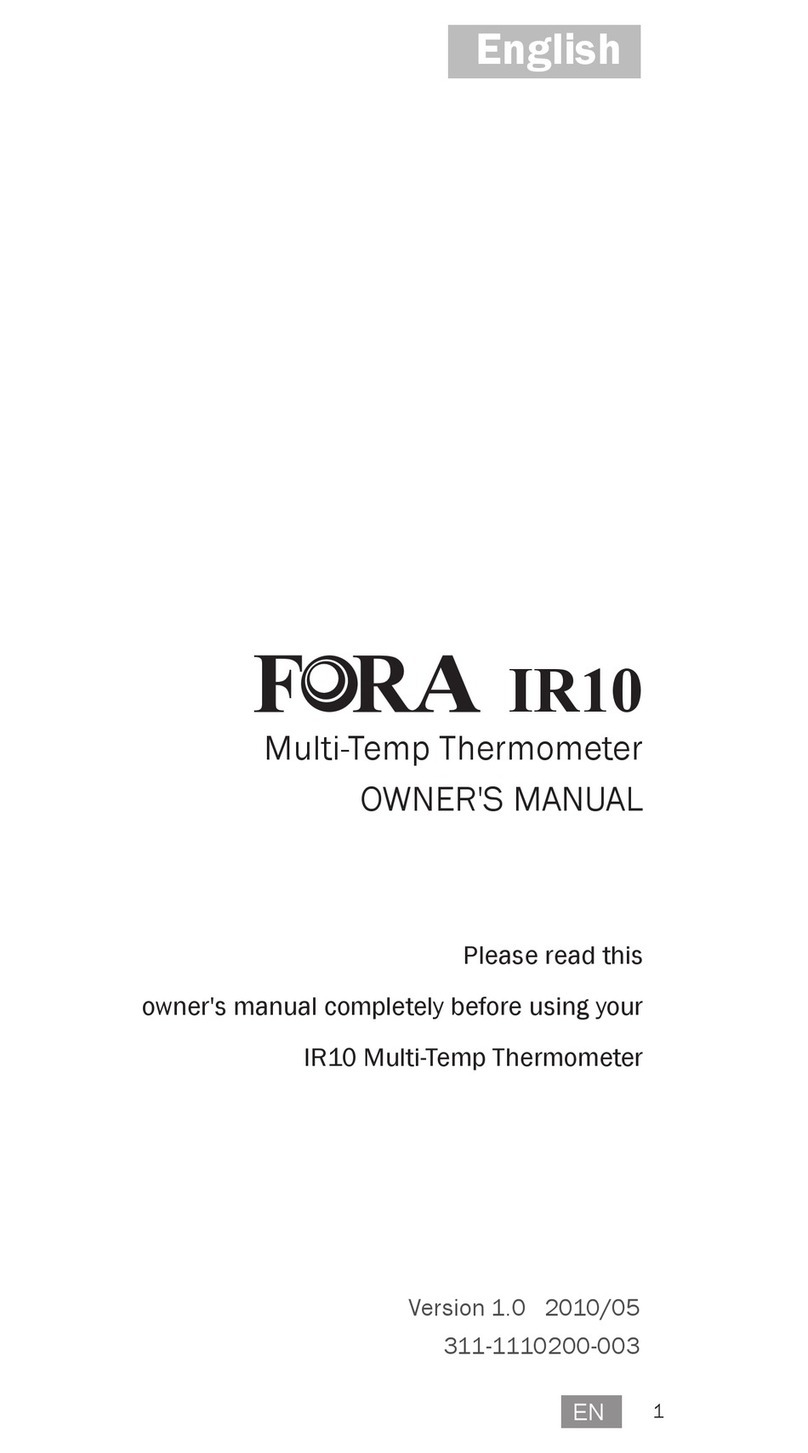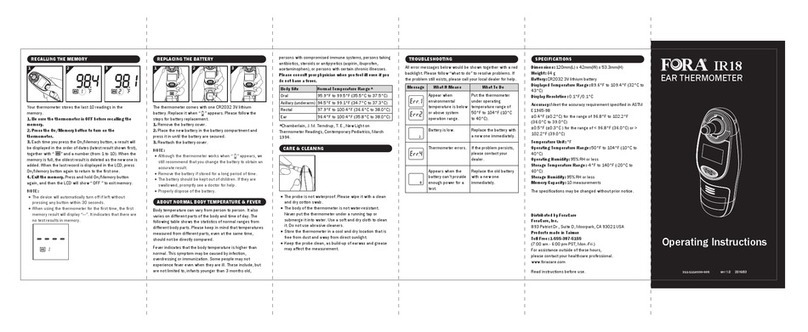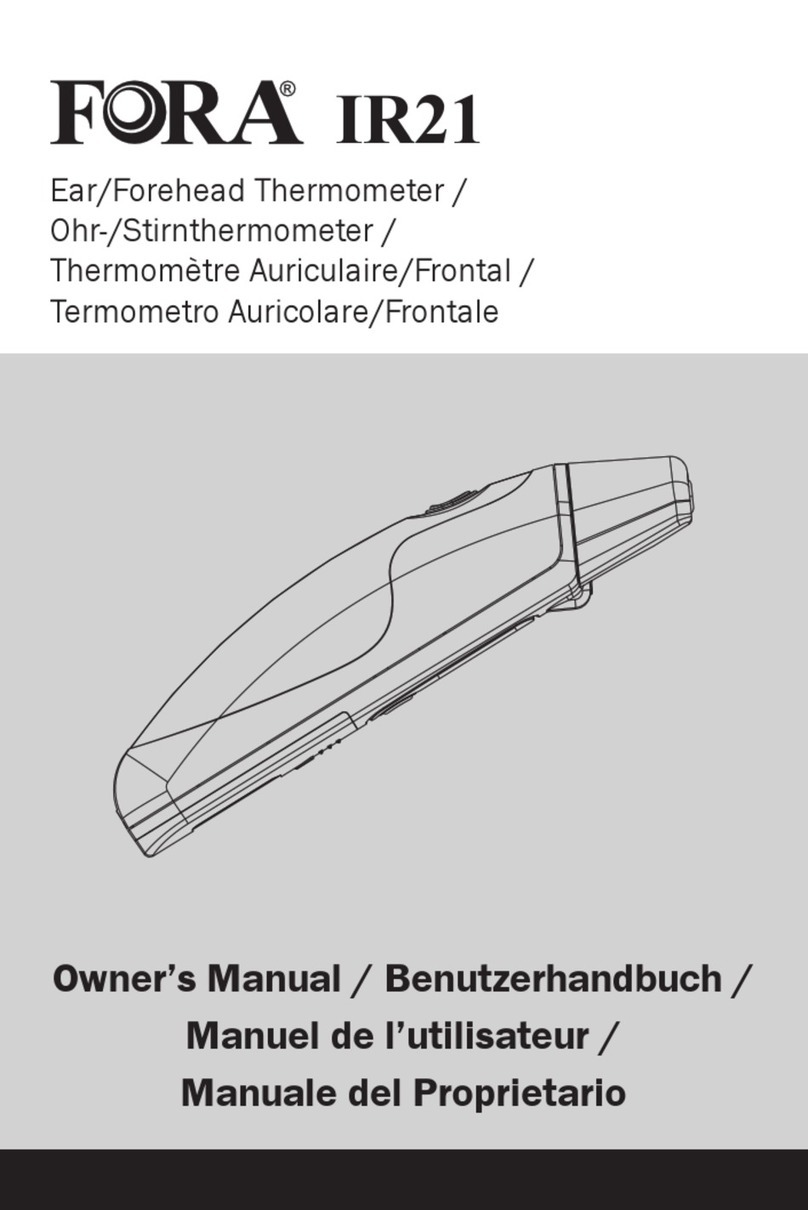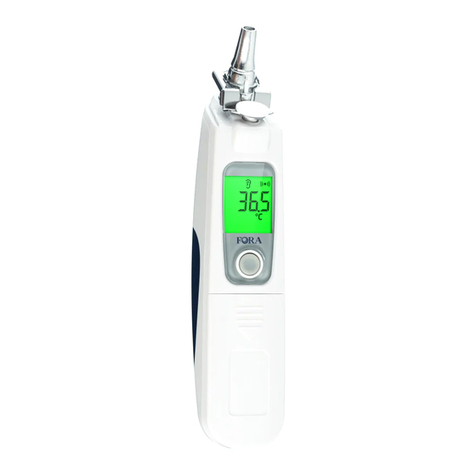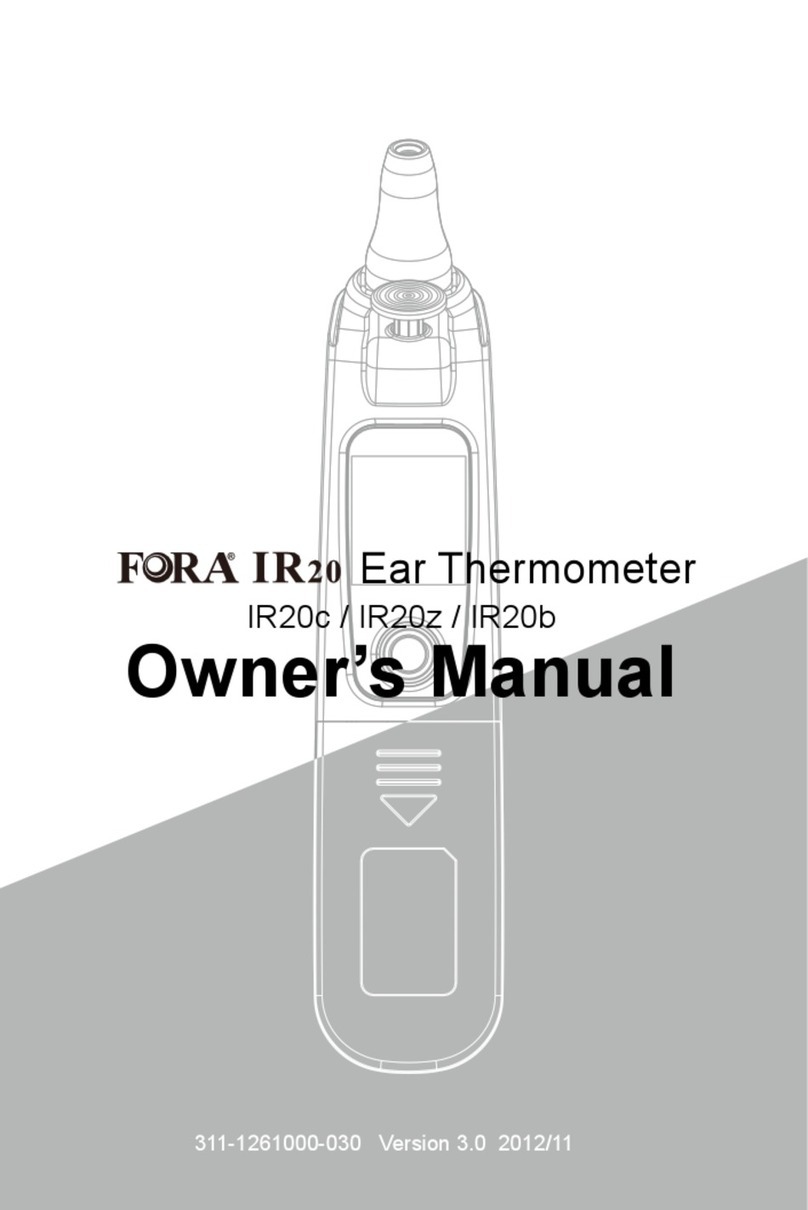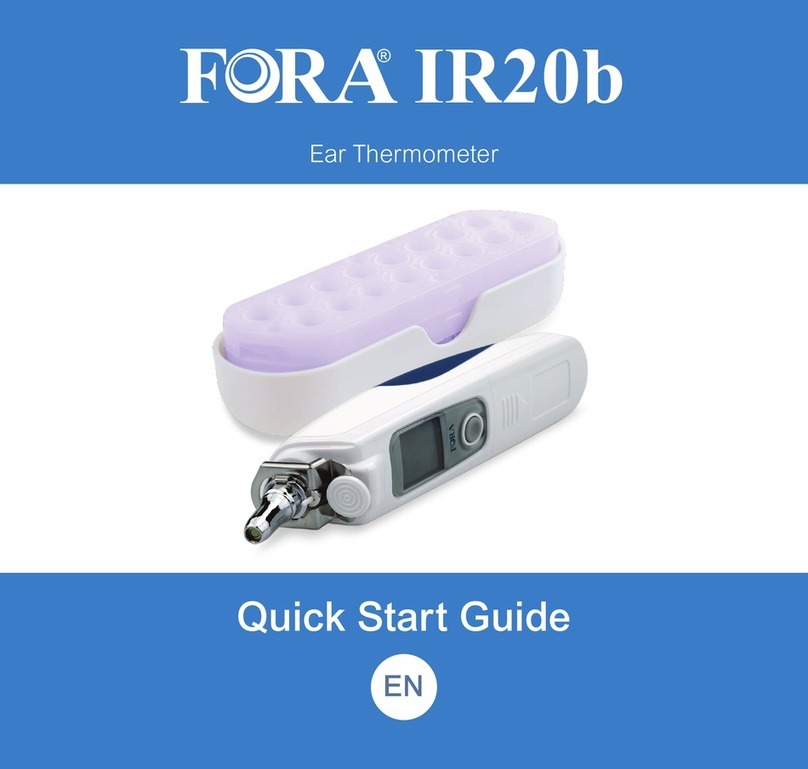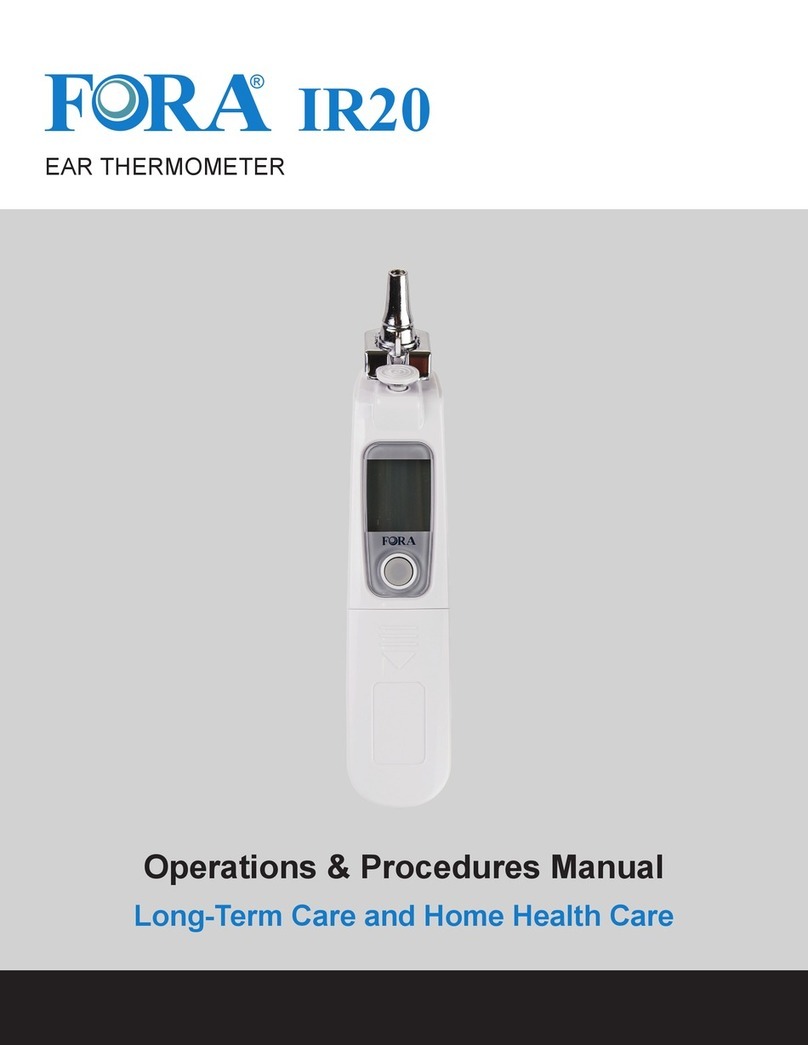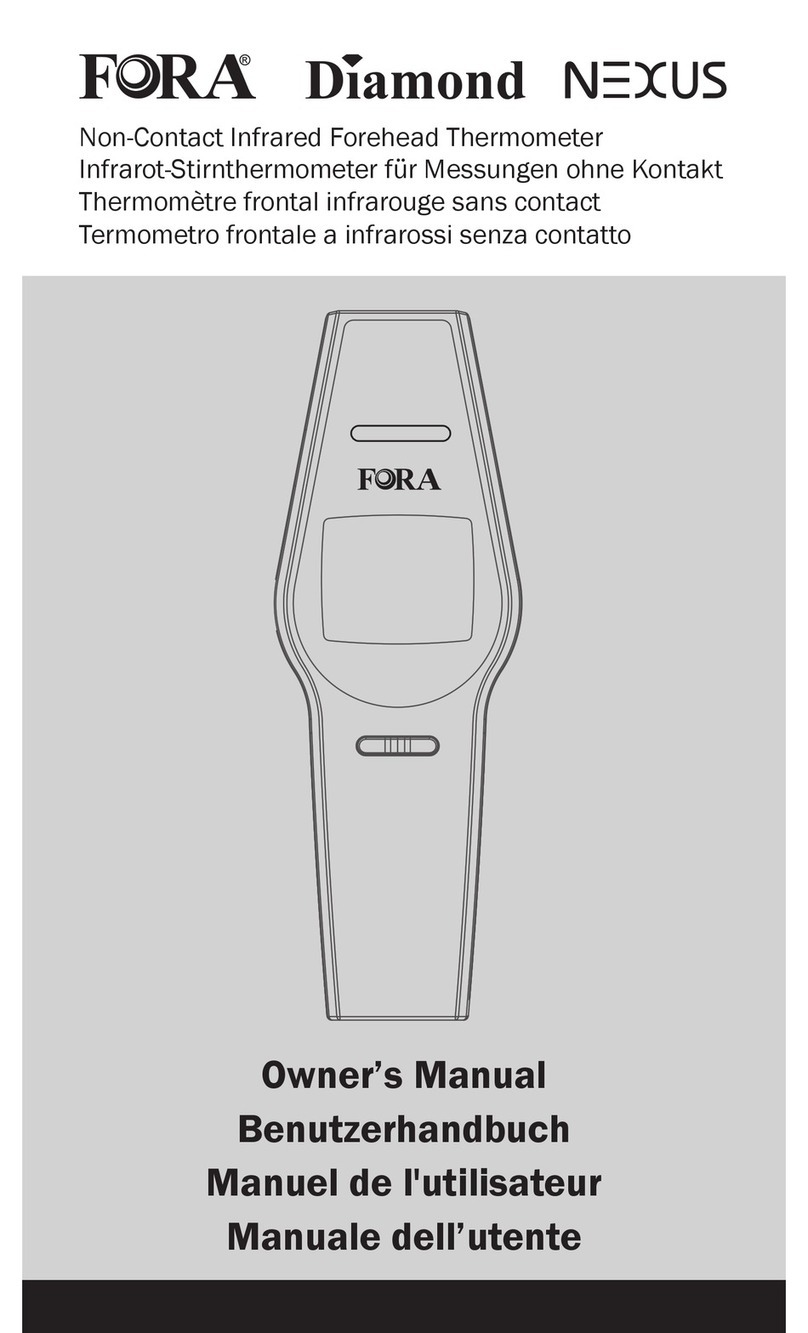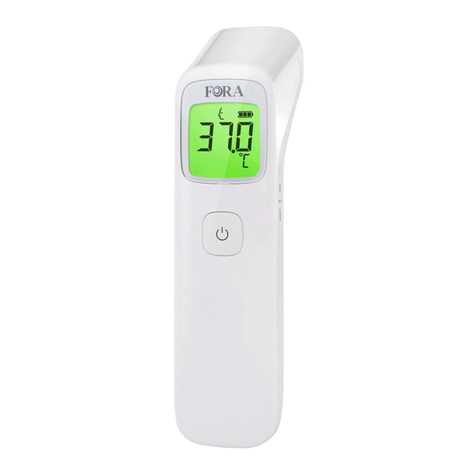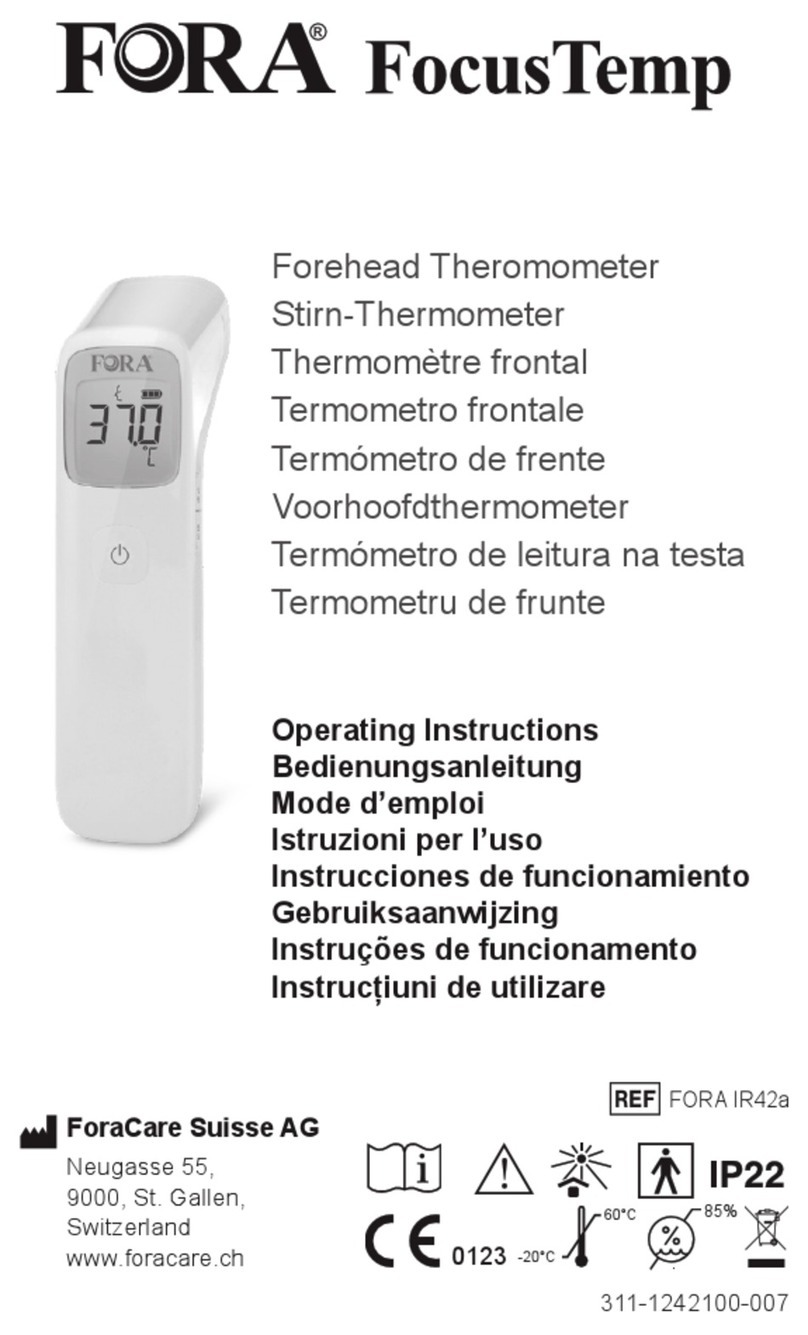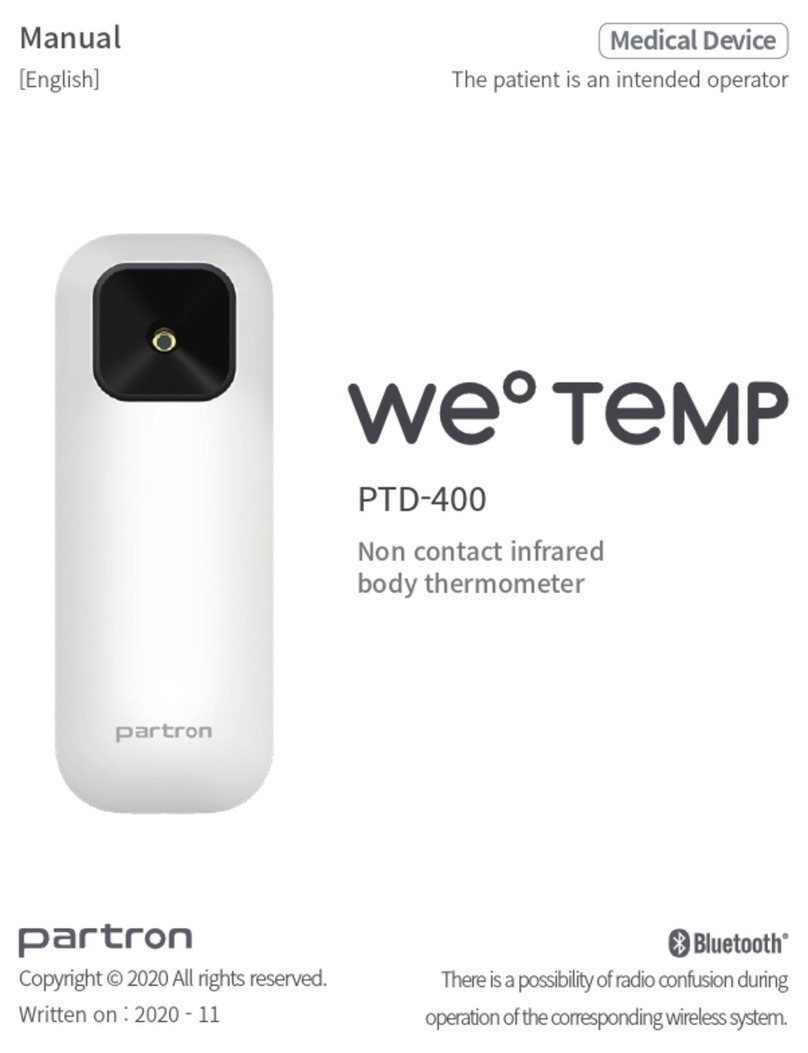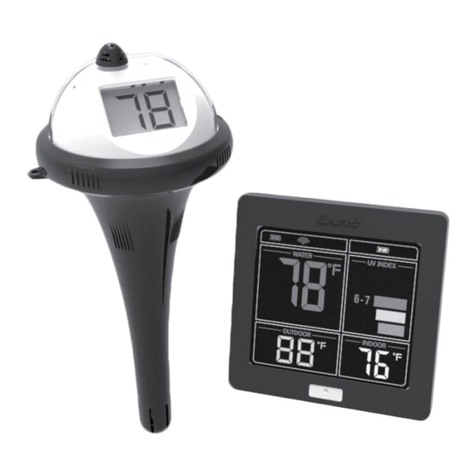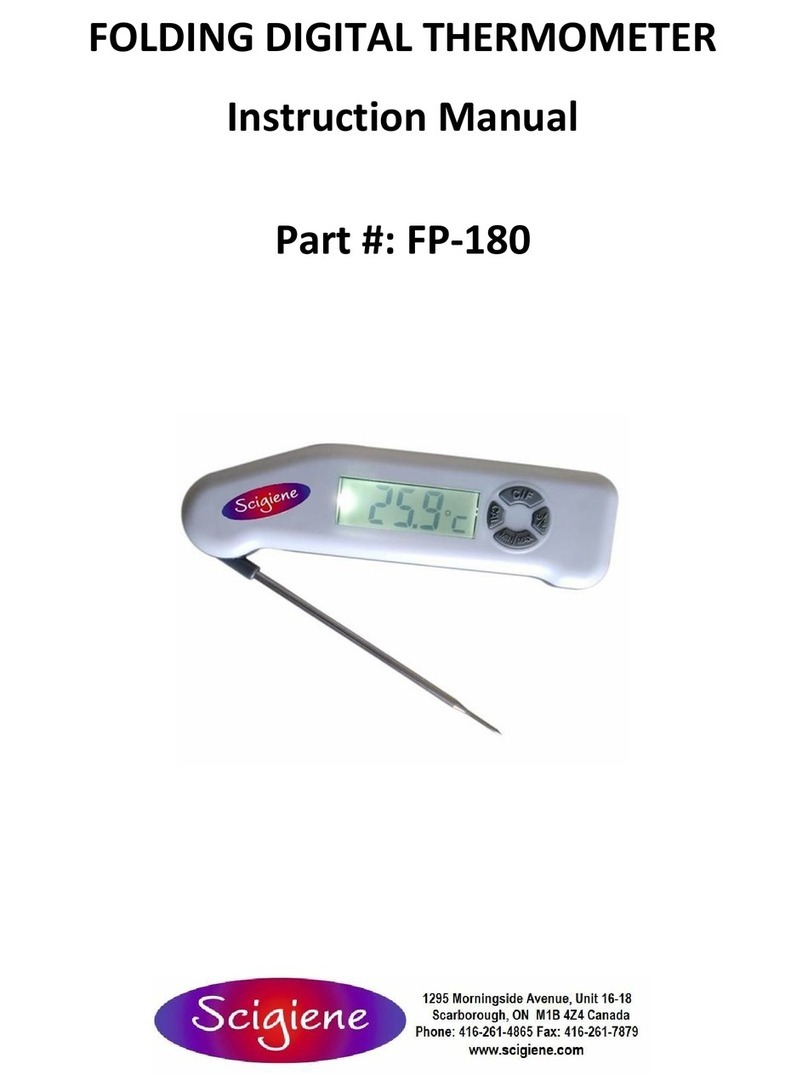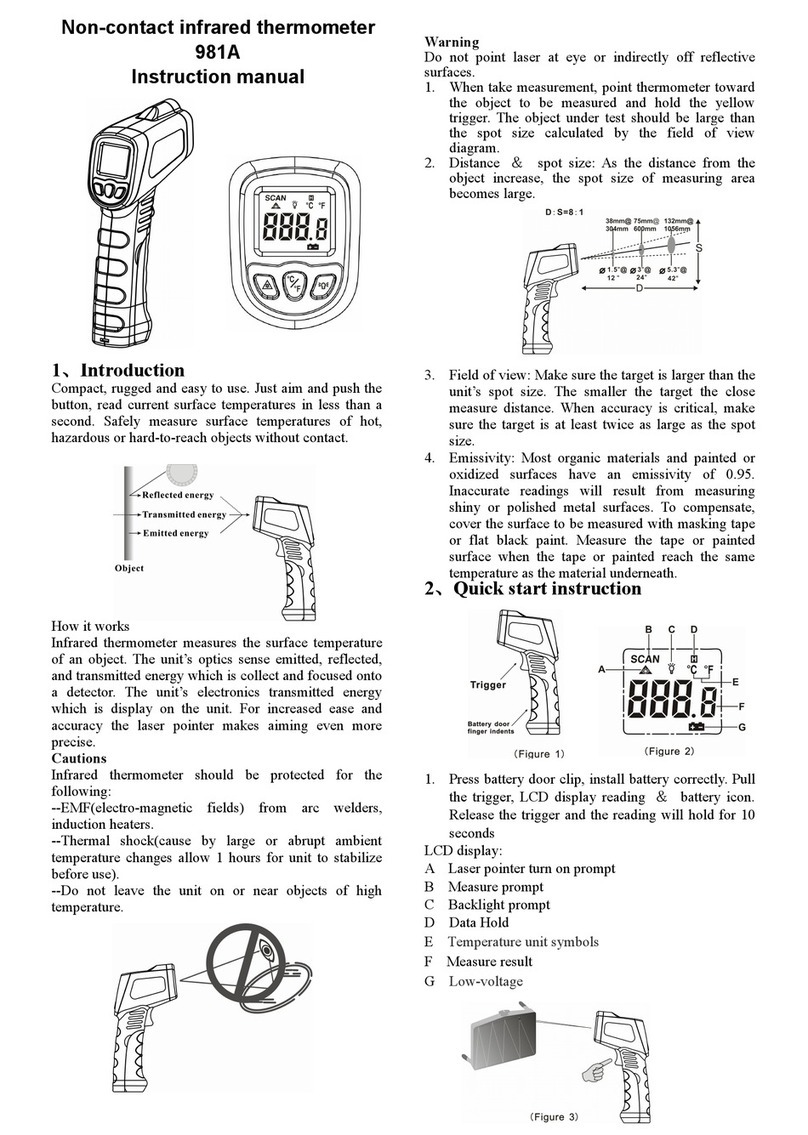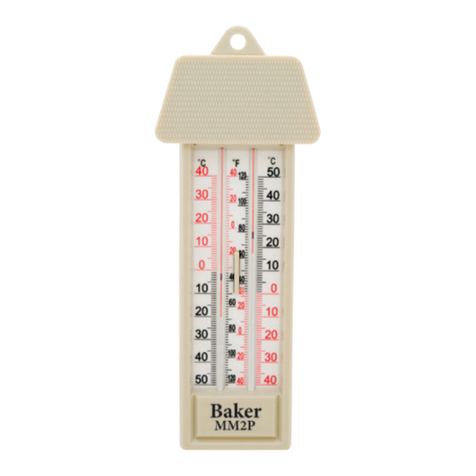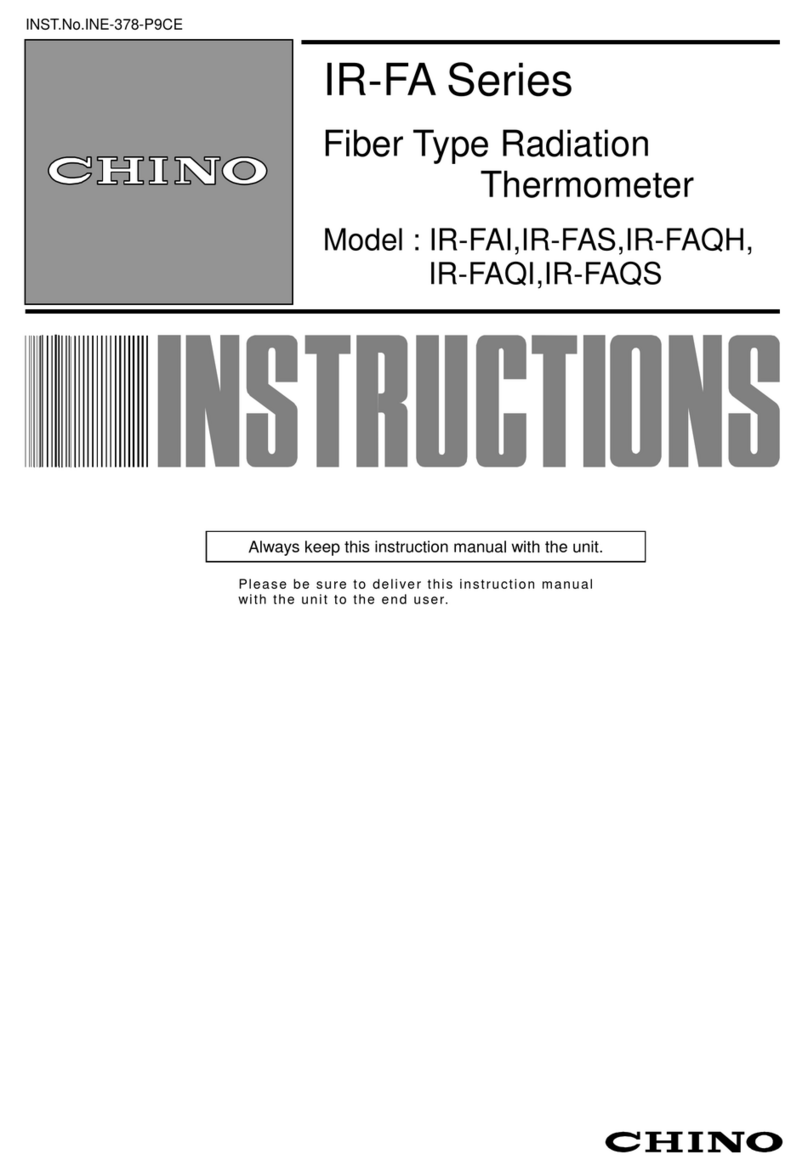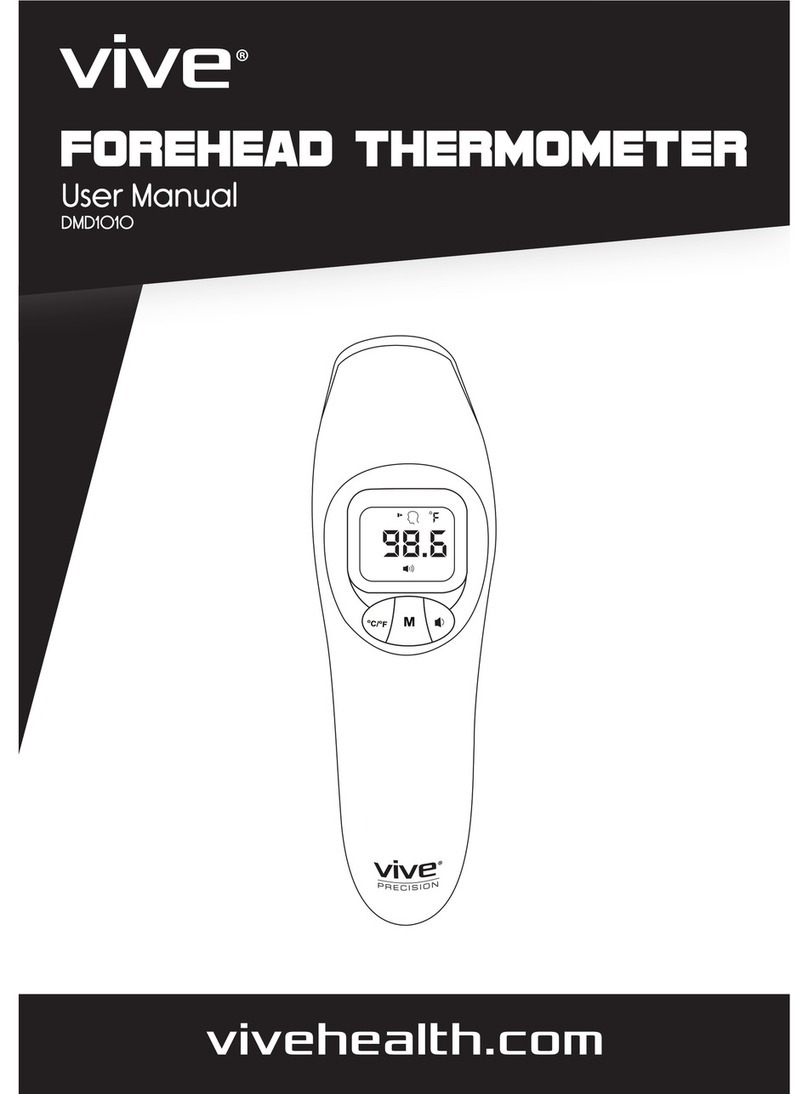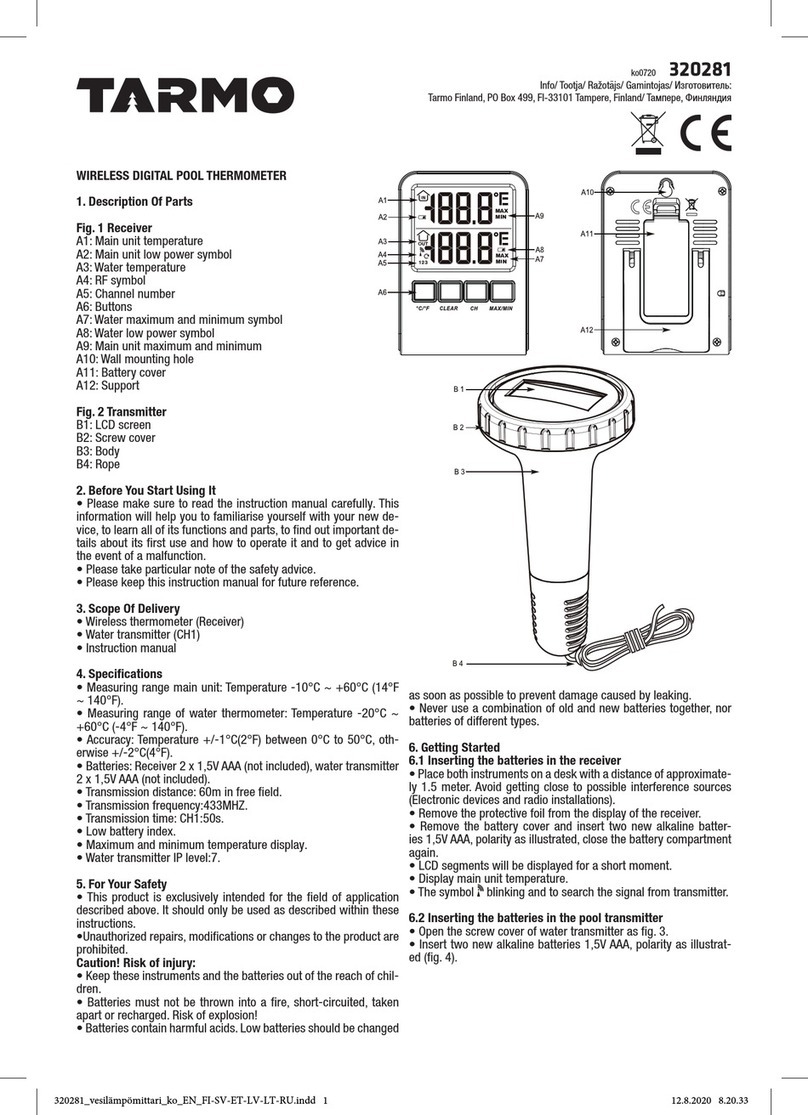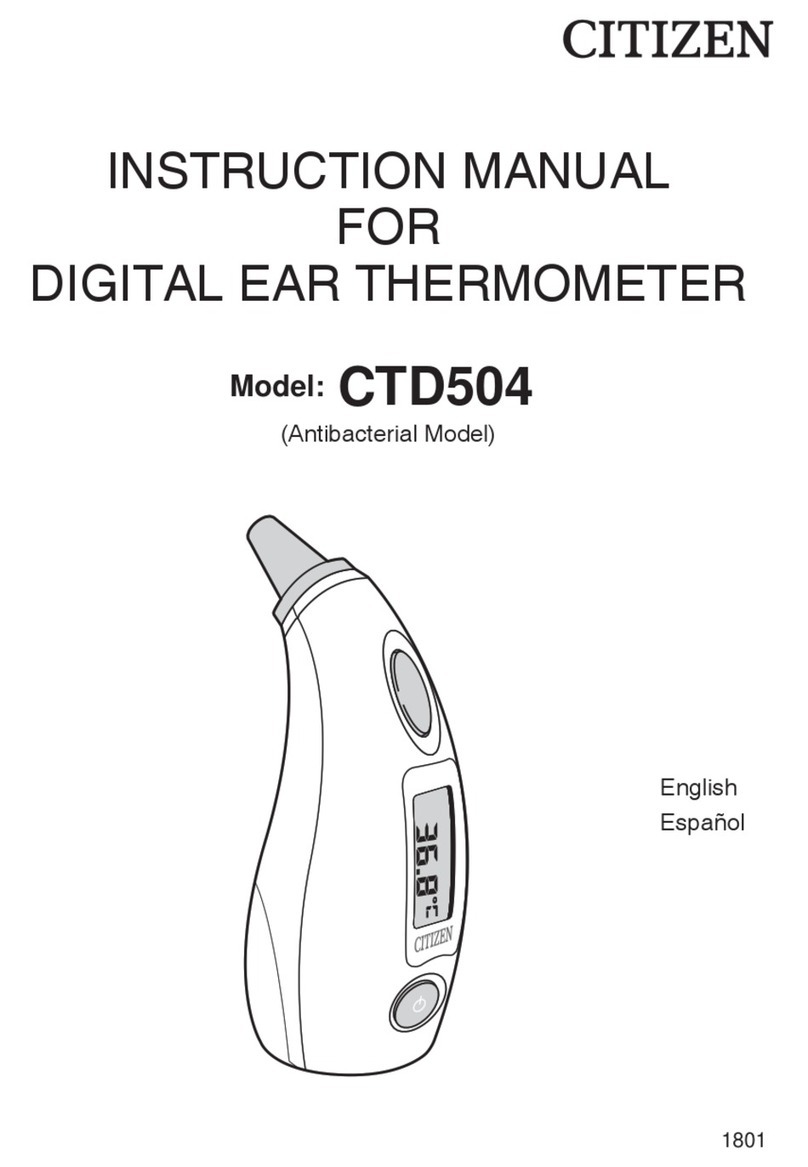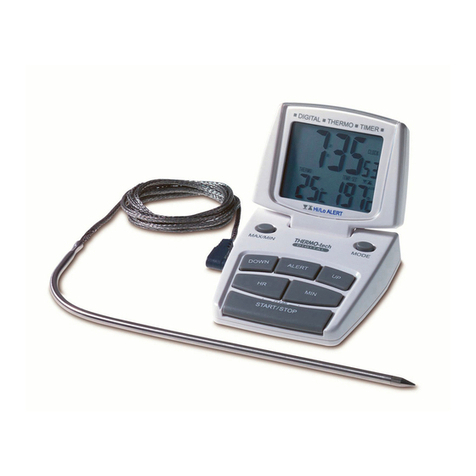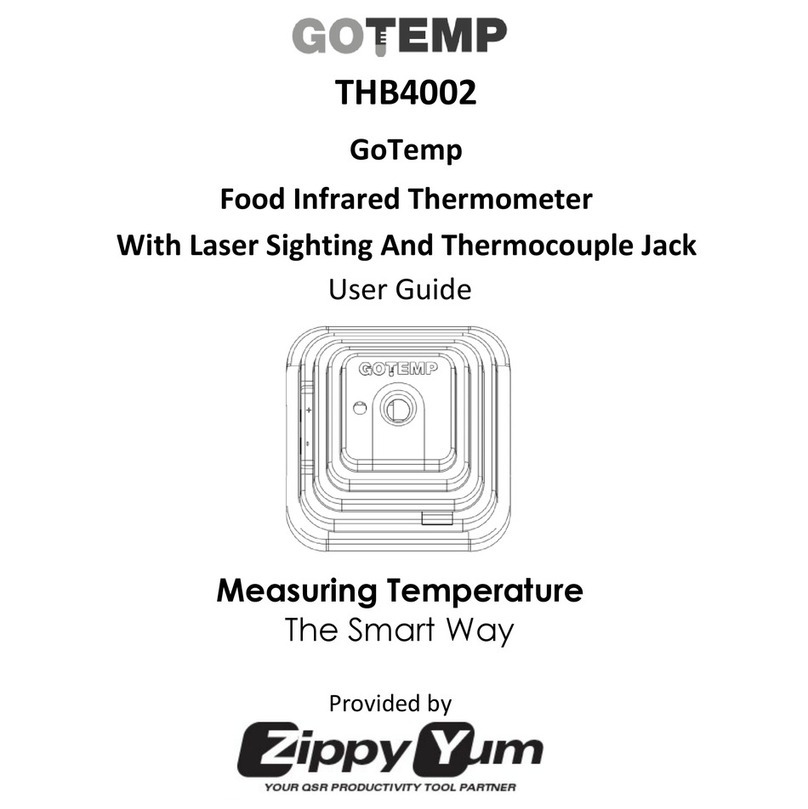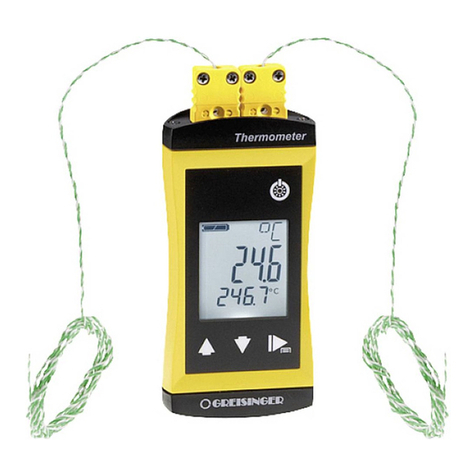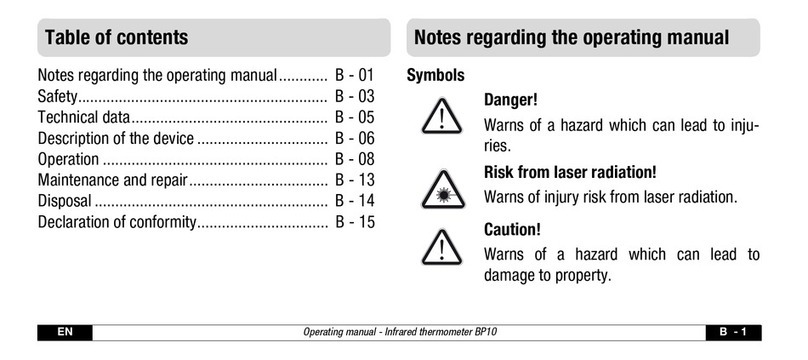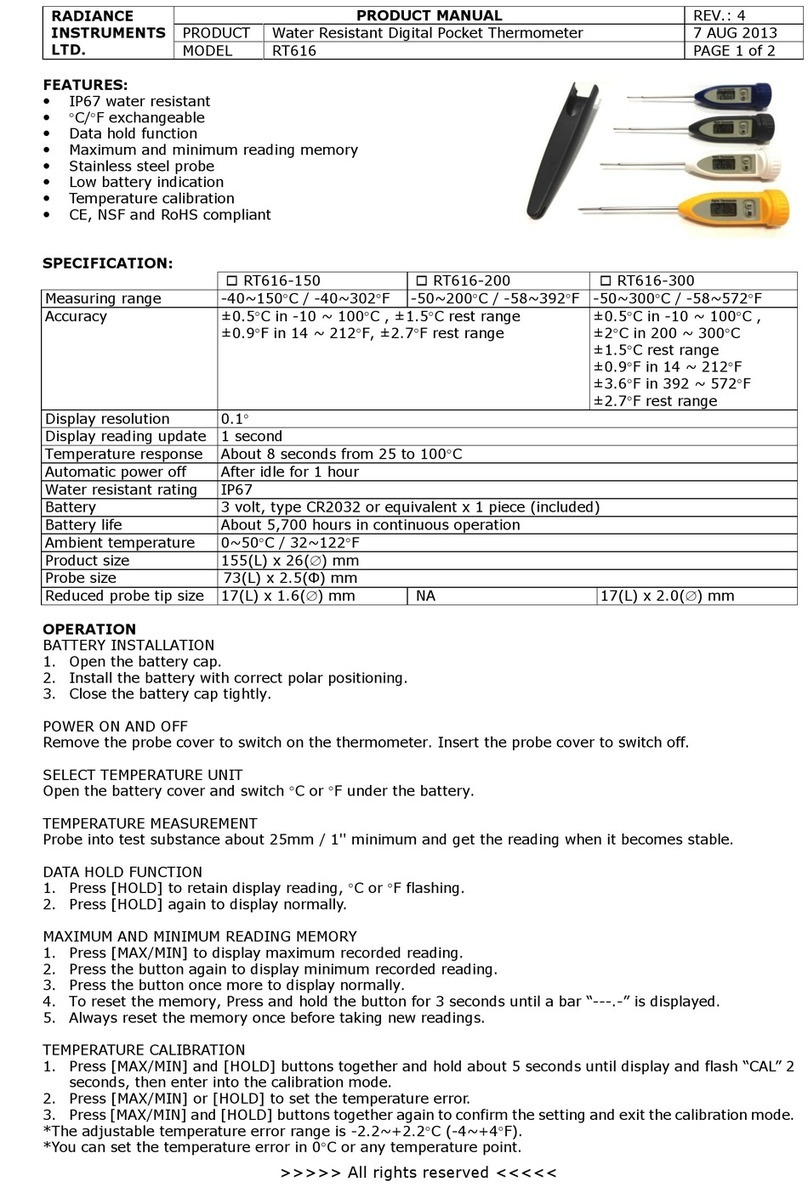
CAUTIONS AND WARNINGS
• As with any thermometer, proper technique is crucial to getting accurate
temperature readings. Please read this manual thoroughly and carefully
before use.
• Always operate the thermometer in temperatures between 16°C to 40°C
(60.8°F to 104°F) and relative humidity less than 95%.
• Always store the thermometer in a cool and dry place: temperatures between
-20°C to 60°C (-4°F to 140°F); relative humidity less than 95%. Avoid direct
sunlight.
• Avoid dropping the thermometer.
• Use only FORA IR20 probe covers for the infrared ear thermometer.
• For proper hygiene, do not share or reuse probe covers. Damaged probe
covers may result in error display.
• Do not disassemble the thermometer.
• Basic safety precautions should always be observed, especially when the
thermometer is used on or near children and disabled persons.
• This thermometer is not intended to be a substitution for a consultation with
your physician.
• Keep probe covers out of reach of children.
• Temperature measurements may differ from left to right ear. Always measure
by using the same ear.
RESTRICTIONS OF USE
This thermometer is clinically proven to produce accurate temperature
measurements. However, please be advised if you have the following
situations:
• The accuracy cannot be ensured for a person who has a deformity in their
ear, which prevents the thermometer probe from properly being inserted into
the ear canal.
• The accuracy cannot be ensured when blood or drainage is found in the ear
canal.
• If ear drops or medications have been placed in one ear, take measurements
from the other ear.
• For a person who wears an ear plug or hearing aid, remove the device and
wait for 15 minutes before taking temperature.
NOTE: Never try to clean inside your ears. You may accidentally damage the
eardrum or its surrounding tissues. Remove excess earwax only when you can
reach it with a clean cloth. Consult a physician if you suspect the presence of
excess earwax.
LCD SCREEN
311-1242000-XXX
Version 1.0 2021/06
INTRODUCTION
Thank you for choosing FORA IR20 ear thermometer. This innovative medical
device relies on advanced infrared (IR) technology to measure temperature
instantly.
INTENDED USE
FORA IR20 ear thermometer is intended for the intermittent measurement and
monitoring of human body temperature from ear canal. The device is intended
for use by people of all ages for home and professional use.
HOW DOES IT WORK
The thermometer measures the infrared heat generated by the eardrum and its
surrounding tissue. The thermometer then converts it into a temperature value
shown on the LCD screen.
APPEARANCE AND KEY FUNCTIONS OF
THE THERMOMETER
1Scan Button
Probe Lens
Probe
Probe Cover Detector
Probe Cover Ejection Button
On/Memory Button
Manufacturing Label
Battery Cover
Probe Cover
Bluetooth Indicator
2
3
4
5
6
7
8
9
10
USING THE DEVICE
MEASURING TEMPERATURES VIEWING RESULTS ON A MOBILE DEVICE
1Temperature Scanning In Progress
Temperature Reading
Memory Mode
Record Numbers
Low Battery Indicator
Temperature Unit
Communication Symbol
No Probe Cover Detected
Ear Temperature Indicator
2
3
4
5
6
7
8
9
ABOUT NORMAL BODY TEMPERATURE &
FEVER
Body temperature can vary from person to person. It also varies on different
part of the body and time of day. The following table shows the statistics of
normal ranges from different body parts. Please keep in mind that tempera-
tures measured from different parts, even at the same time, should not be
directly compared.
Fever indicates that the body temperature is higher than normal. This symptom
may be caused by infection, overdressing or immunization. Some people may
not experience fever even when they are ill. These include, but are not limited
to, infants younger than 3 months old, persons with compromised immune
systems, persons taking antibiotics, steroids or antipyretics (aspirin, ibuprofen,
acetaminophen), or persons with certain chronic illnesses. Please consult
your physician if you are concerned about your body temperature
readings.
Oral
Axillary (underarm)
Rectal
Ear
Body Site Normal Temperature Range*
35.5°C to 37.5°C (95.9°F to 99.5°F)
34.7°C to 37.3°C (94.5°F to 99.1°F)
36.6°C to 38.0°C (97.9°F to 100.4°F)
35.8°C to 38.0°C (96.4°F to 100.4°F)
IR20
EAR THERMOMETER
Operating Instructions
1
5
2
3
4
9
10
6
7
8
ForaCare Technology Canada, Inc.
2103-11871 Horseshoe Way
Richmond, B.C. V7A 5H5 Canada
Products made in Taiwan
T: (604)358-5601
(9:00 am - 6:00 pm PST, Mon.-Fri.)
www.foracarecanada.com
IMPORTANT SAFETY INSTRUCTIONS
READ THIS BEFORE USING AND KEEP THESE INSTRUCTIONS IN A
SAFE PLACE
The following basic safety precautions should always be taken.
1. Close supervision is necessary when the thermometer is used by, on, or
near children, handicapped persons or invalids.
2. Use the thermometer only for the intended use described in this manual.
3. Do not use the thermometer if it is not working properly, or if it has suffered
any damage.
4. Do not use accessories which are not supplied or recommended by the
manufacturer.
5. Proper maintenance is essential to the longevity of your device. If you are
concerned about your accuracy of measurement, please contact the local
customer service or place of purchase for help.
6
1
2
3
9 8 7
4 5
1 2
Replacing the Probe Cover
1. Check if the probe cover is clean and new. Press the infrared probe into
the cartridge.
2. Secure the cover to the probe and remove it from cartridge.
NOTE:
• If a probe cover is not attached on the probe, LCD will show “ ” until a new
probe cover is firmly attached to the probe.
• The used probe cover should be removed after each measurement to ensure
accuracy.
• To ensure proper hygiene, attach a new probe cover each time and do not
touch its tip.
1 2 31
514
1. Press and release the On/Memory button to turn on the thermometer.
When ready, the thermometer displays the last measurement.
2. Gently fit the probe with a clean probe cover into the ear canal.
3. Press and release the Scan button. You will hear a beep to indicate the
measurement is complete and the thermometer can be removed.
4. Read the result. “ ” and “ ” are shown together with a temperature
value.
5. Press the ejection button to discard the used probe cover into a trash can.
NOTE: Turn off the thermometer by pressing On/Memory button twice. It will
automatically turn off if left idle for 3 minutes.
RESULT INDICATORS
“Lo” with red backlight
Result with green backlight
Result with red backlight
“Hi” with red backlight
Temperature ≤ 31.9°C (89.5°F)
32°C (89.6°F) ≤ Temperature < 37.9°C (100.3°F)
38°C (100.4°F) ≤ Temperature < 43°C (109.4°F)
Temperature ≥ 43.1°C (109.5°F)
Status
The Bluetooth function is enabled and waiting for connection.
The Bluetooth connection is established.
Bluetooth Indicator
Flashing Blue
Solid Blue
HINTS ON TAKING TEMPERATURES
1. As with other thermometers, you may observe slight variations in consecu-
tive measurements. It is recommended that you take 3 temperature
readings and use the highest one for the following situations:
• Infants younger than 3 months old.
• Children younger than 3 years old and who have a compromised immune
system and the presence / absence of fever is critical.
• When you are learning to use the thermometer.
2. Do not take a reading while the patient is moving and/or talking. Wait for 30
minutes after any of the following situations before taking a measurement:
• When the ear has been covered.
• After exercising, swimming, or taking a bath.
• When the patient has been exposed to extreme temperature.
3. To take accurate readings, the ear must be free from excessive earwax
build-up.
RECALLING THE MEMORY
12
Your thermometer stores last 10 readings in the memory.
1. Be sure the thermometer is OFF before recalling the memory.
2. Press the On/Memory button to turn on the thermometer.
3. Press the On/Memory button for 3 seconds to enter memory mode. Each
time you press the On/Memory button, a result will be displayed in the
order of dates (latest result shown first), together with “ ” and number
(from 1 to 10). When the memory is full, the oldest result is deleted as the
new one is added. When the last record is displayed in the LCD, press
On/Memory button again to return to the first one.
4. Exit the memory. Press On/Memory button again, and then the LCD will
show “ OFF ” to exit memory.
11 133
You can transmit your data from the meter to your devices (e.g. smart phone,
tablet, PC…) via Bluetooth. Please contact your local customer service or
place of purchase for assistance. Please note that you must complete the
pairing between the meter and Bluetooth receiver before transmitting data.
Pairing with your mobile device
1. On your mobile device, turn on the Bluetooth function and follow the
pairing instructions inside of the APP (e.g., scan for the meter to add it into
APP).
2. After each measurement, the Bluetooth will be turned on automatically to
transmit data to APP.
Bluetooth indicator on the meter
WARNING:
• While the meter is in transmission mode, it will be unable to perform a test.
• Make sure your device with iOS (6 or above) or Android System (4.3 or
above) has turned on Bluetooth before transmitting the data and the meter is
within the receiving range.
REPLACING THE BATTERY
The thermometer comes with two 1.5V AAA alkaline batteries. Replace them
when “ ” appears. Please follow the steps for battery replacement.
1. Remove the battery cover.
2. Place the new batteries in the battery compartment and press it in until the
batteries are secured.
3. Reattach the battery cover.
NOTE:
• Although the thermometer works when “ ” appears, we still recommend that
you change the batteries to obtain an accurate result.
• Remove the batteries if stored for a long period of time.
• The batteries should be kept out of children. If they are swallowed, promptly
see a doctor for help.
• Properly dispose of the batteries.
132
*Chamberlain, J. M. Terndrup, T. E., New Light on Thermometer Readings,
Contemporary Pediatrics, March 1994.

